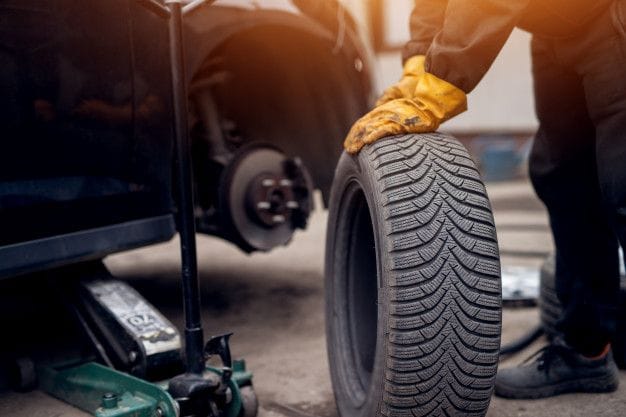Can I Drive with a Punctured Tyre? Risks, Safety Tips and What to Do

Introduction
Can I drive with a punctured tyre? Discovering a puncture while driving can be alarming. Many drivers face the dilemma: should you keep driving or stop immediately? The answer depends on the severity of the puncture.
This guide covers:
- When and how far you can drive on a punctured tyre
- The risks of driving with a flat or damaged tyre
- How to handle a puncture safely
- Preventive measures to avoid future flats
Understanding these factors will help you make the right decision in an emergency.
Key Takeaways
- Never drive far on a flat tyre – it’s dangerous and can damage your wheel
- Slow punctures may allow short, cautious driving to a repair shop
- Watch for warning signs like loss of pressure, bulges, or steering vibrations
- Know emergency steps: pull over safely, assess damage, use a spare or call for help
- Prevention is key – regular tyre checks reduce puncture risks
1. Can You Drive with a Punctured Tyre? (It Depends on the Situation)
Scenario 1: Slow Puncture (Minor Air Loss)
- You may drive short distances to reach a repair shop
- Maintain speed under 30mph to prevent further damage
- Avoid sharp turns and sudden braking
Scenario 2: Complete Flat (No Air Left)
- Do not drive – even short distances can ruin the tyre and wheel
- Call for roadside assistance or fit the spare tyre
Scenario 3: Sidewall Puncture or Bulge
- Stop driving immediately – sidewall damage is unsafe at any speed
2. Risks of Driving on a Flat or Punctured Tyre
Continuing to drive with a puncture can cause:
Wheel and Suspension Damage
- A flat tyre shifts weight unevenly, potentially bending the rim or damaging suspension components
Loss of Vehicle Control
- Reduced grip increases skidding risk, especially in wet conditions
Potential Blowout
- Heat buildup from driving on low pressure may cause sudden tyre failure
Expensive Repairs
- Driving on a flat often destroys the tyre, requiring complete replacement
3. What to Do If You Get a Puncture
Step 1: Pull Over Safely
- Activate hazard lights and park on level ground
Step 2: Assess the Damage
- Determine if it’s a slow leak or complete flat
- Check for visible damage like nails or sidewall bulges
Step 3: Decide Your Next Action
- For minor punctures: use a temporary repair kit if available
- For serious damage: fit the spare tyre or call for assistance
Step 4: Visit a Tyre Specialist
- Even temporary fixes require professional inspection
4. How to Prevent Punctures
Regular Tyre Maintenance
- Check tread depth and pressure monthly
Avoid Road Hazards
- Steer clear of potholes and debris when possible
Consider Puncture-Resistant Tyres
- Some tyres feature reinforced construction to resist punctures
Carry Emergency Supplies
- Keep a tyre repair kit and pressure gauge in your vehicle
FAQs: Common Questions About Punctured Tyres
Can I drive a short distance on a flat tyre?
No – even brief driving can cause permanent damage to the tyre and wheel.
How far can I drive with a slow puncture?
Only to the nearest repair facility, at reduced speed (under 30mph).
Are punctured tyres repairable?
Small tread-area punctures can often be repaired, but sidewall damage requires replacement.
Does car insurance cover punctures?
Most policies exclude wear-related damage but may include roadside assistance.
Is tyre sealant a permanent fix?
No – it’s a temporary solution until proper repairs can be made.
Final Advice: Prioritize Safety
Driving on a punctured tyre is both dangerous and potentially illegal. While slow leaks may permit cautious movement to a repair shop, a complete flat demands immediate attention.
For professional tyre services, consult your local tyre specialist. Remember – well-maintained tyres are essential for safe driving.
Conclusion: Safety First When Dealing with Punctured Tyres
Discovering a puncture while driving requires quick thinking and careful action. While you may be tempted to continue driving, especially if you’re close to your destination, doing so can put you at risk of losing control, damaging your vehicle, or even causing an accident.
Key Points to Remember:
- Never drive on a completely flat tyre – Even a short distance can cause irreversible damage to your wheel and suspension.
- Slow punctures may allow cautious driving – But only at low speeds and directly to a repair shop.
- Sidewall damage is especially dangerous – If you notice a bulge or cut in the sidewall, stop driving immediately.
- Prevention is better than repair – Regular tyre checks for pressure, tread depth, and damage can help avoid punctures.
- Be prepared – Keep a spare tyre, jack, and repair kit in your car for emergencies.
If you’re ever unsure about the condition of your tyre, it’s always safer to pull over and call for professional assistance. Your safety—and the safety of others on the road—should always come first.
For reliable tyre inspections and repairs, visit a trusted local tyre specialist. Proper maintenance and quick action when problems arise will keep you driving safely for miles to come.